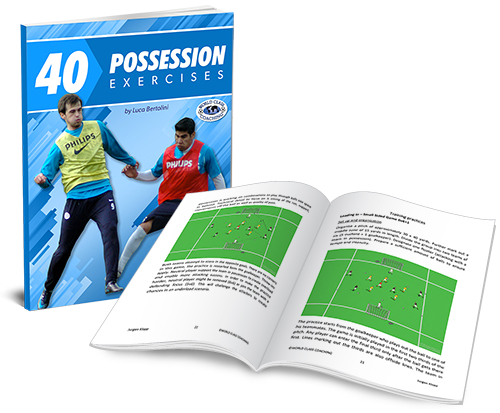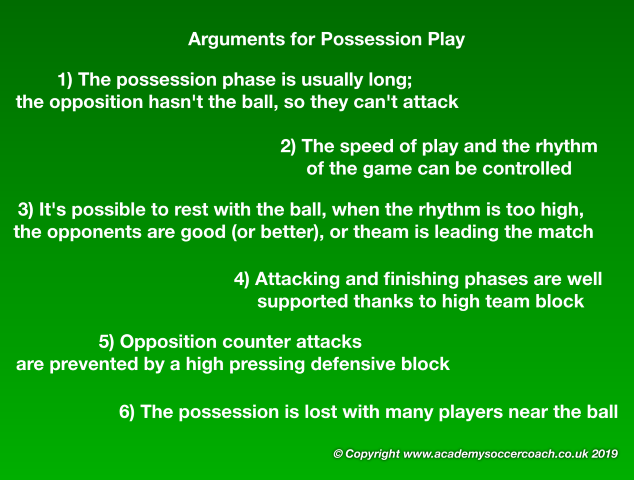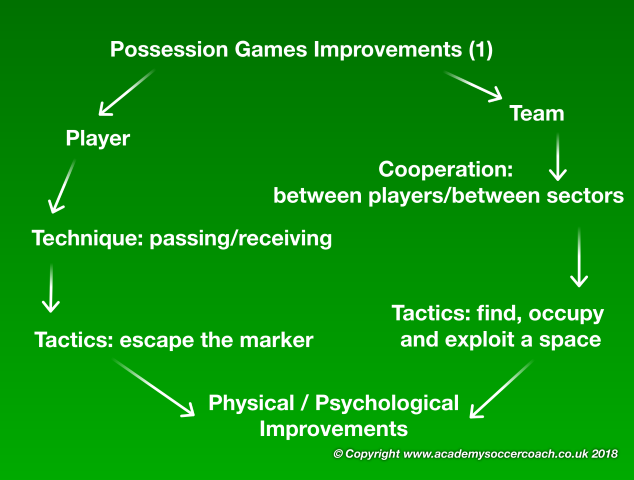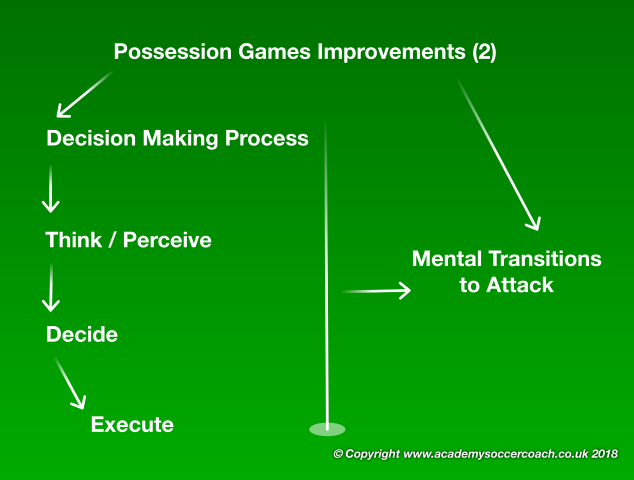WORLD CLASS COACHING
40 Possession Exercises
By Luca Bertolini

Table of Contents
PART ONE
Introduction
Types of Ball Possession
Direct Play v Possession Play
PART TWO
Possession Exercises 1
PART THREE
Possession Exercises 2
PART FOUR
Possession Exercises 3
Introduction - how to calculate and consider the average of ball possession
Pep Guardiola, in Pep Confidential, by Martí Perarnau, says that possession should not be done just for the sake of it. Ball possession needs to be done with an ultimate objective in mind.
Pep Guardiola says,“It’s not possession or one-touch passing that matters, but the intention behind it. The percentage of possession a team has or the number of passes that a group or an individual makes is irrelevant in itself. What’s crucial is the reason they are doing these things, what they are aiming to achieve and what the team plans to do when they have the ball. That’s what matters!”
In the book, Guardiola also explains the 15-pass build-up rule: “Having the ball is important if you are going for 15 consecutive passes in the middle of the field in order to maintain your shape, whilst at the same time upsetting the opposition’s organization. How do you disorganize them? With fast, tight, focused passing as part of this 15-move sequence.”
The debate around soccer ball possession started and increased during the Spanish “tiki-taka" of Guardiola’s Barcelona and of the national Spanish team seasons. The perception of the importance of ball possession is not recent. For example, Johan Cruijff used to say: “Without the ball, you can’t win. If we have the ball, they can’t score.”
How is ball possession calculated and is the focus on ball possession a synonymous with success? Do teams play better if they are focused on ball possession, or do better teams have higher quality, and is this the only reason why they can complete more passes?
During the 2000’s, possession percentage has been considered the main key factor to judge the quality of a team: the higher the ball possession percentage, the better the team was. Even if possession percentage progressively lost importance, it still a key factor to understand and for a complete assessment of a team philosophy or style of play.
Or better yet, the detection method of the ball possession has changed, as it doesn't really matter the time of possession of a soccer team anymore; the number of completed passes in a game has become the main theme to be focused on. Nowadays, the possession percentage is calculated on these data, paying attention to not overstate the percentages related to those teams with high amounts of short passes in the build-up phase (Manchester City and Napoli, for example).
A new idea about possession percentage considers it as the possession starts upon a player controlling the ball and ends when they no longer do; the total possessions for each team are then added up and divided by the total number of possessions.
The methods have the goal to understand if, when and how the possession phase of a team is effective, and if it leads to goals and victories.
Possession play means more time spent in the opposing half, more chances to score goals, less time on the ball for the opponent and then fewer chances to score. The possession team maybe vulnerable to counter attacks when the possession is lost and the pressure phase is not well organized.
The slow play rhythm means losing out on counter attacking opportunities. The attacking phase may become predictable for the defense if the speed and rhythm of play are not properly controlled and varied. If the opposition goal is well covered defensively and if the opposition is prepared to put many players inside the final third (their first third), finishing becomes very hard as quick opportunities may be wasted; again, variations of rhythm and speed of play are crucial.
Keeping the possession eventually makes the opposing team frustrated and more prone to mistakes. The possessing team controls the pitch, analyzing all the options and dictating the phases of play and opposition. Players' vision and speed of play are crucial.
Being able to pass the ball precisely and fast is important: the more a team moves the ball, retaining possession, the higher their chances to disorganize the opponents’ lines and to exploit attacking opportunities are. One way to increase such efficiency is to move the ball fast. To do so, being able to pass it with as few touches as possible is the key.
On the other side, if a high defensive line is needed to play with a possession style, the team may be vulnerable to counterattacks.
Types of ball possession
When does ball possession begin? This time may be set to the moment of first contact with the ball of the player, or, more realistic, the ball is considered to be in a player's possession when it's around his action space. Ball possession can be then defined as follows:
Team ball possession is a sequence of individual ball possession phases, which are made of one or more phases in which an action can be performed with the ball, becoming individual ball actions. It is possible for an individual ball action to be separated from the phases without ball control (while the ball is in the air, as instance). An individual ball control is an individual ball action where the ball control is present. Team ball control is the union of all team ball phases; team play making is the team ball control plus the intermediate void phases.
Individual ball possession begins the moment a player is able to perform an action with the ball and it ends the moment for another player begins.
Team ball possession begins the moment when an individual ball possession for one team's players begins and it ends with the first opposition individual ball possession begins.
The time interval in which a player can perform an action with the ball is then separated out from this simple definition of ball possession. This interval no longer includes the time from the ball being passed on until the start of individual ball possession of the next player. It is important to make this distinction in view of the fact that the configuration on the pitch during this time interval determines the tactical options available and their chances of success.
Individual ball action of a player begins the moment this player is able to perform an action with the ball and had no one else prior to this. It ends the moment the player is unable to perform any further action with the ball.
A further internal distinction can be made based on the level of ball control exhibited. If a player has the ball sufficiently under control and he can consciously chose between several play options or if he must attempt to deliver the ball to a specific area of the pitch being extreme pressure.
Individual ball control for a player begins when the individual for this player begins and he is able to decide between several play options during the individual ball action. It ends the moment this particular individual ball action of the player ends.
Team ball control is the union of all individual ball controls; the period of time during which any player in the team has control of the ball. The "team playmaking" includes the periods of time during which the ball is being passed between the players of a team. Team Ball Control of a team begins when an individual ball control for one of this team's players begins and ends as soon as the individual ball control of this player ends.
Team Playmaking for a team begins when an individual ball control for one team's players begins and the team has had no other individual ball control immediately prior to this. It ends with the last individual ball control before the next individual ball action of a player of the opposing team.
Does a higher ball possession create a competitive advantage and leads to score and win?
Possession style of play can surely give competitive advantage; the average number of passes that a team is able to complete every match is always related to the average number of goals that a team is able to score. The average of goals that a team scores in one match is usually a certain percentage of the average of pass accuracy. The amount of the passes is then related to pass accuracy, which is correlated to the length of the passes themselves (the shorter are obviously the more accurate); and also, there is a high correlation between the number of short passes (<25 yards) and the number of scored goals. The number of goals a team scores clearly depends on the number of shots they take and moreover on the shots on target.
The shot is the final act of a quick or an articulated build-up, or a set piece and the build-up phase is a series of passes. If a team is technically skilled enough to keep the possession, with a pass accuracy of 100%, during an attacking phase, than the result can only be a shot (the team is supposed playing to score); it means that when a team is able to produce many accurate passes, its chances to take shots on goal would increase and moreover the chances to shoot from more suitable positions to score.
What determines pass accuracy? It is players’ technical abilities and how the players interact among one another. Pass accuracy improves when the percentage of short passes (<25 yards) on total passes increases; this is the reason why teammates should always provide multiple passing options near the ball carrier.
To play with short passes rather than with long ones requires the players to be well-positioned on the pitch to form triangles, offering nearby solutions to the teammate with the ball; more passes can be completed staying closer together, and fewer counterattack solutions to the opponents are conceded when the ball is lost. As Johan Cruijff was used to say, it isn’t the man on the ball who decides where the ball goes, but the players without the ball. Their running actions determine the next pass.
The number of passes, by itself, cannot really identify if a team is successfully possession oriented or not. More important than the number of passes is therefore where on the pitch a team touches the ball and the speed of the passes between the opposition’s lines.
Possession and positional play
Coaches like Pep Guardiola and Maurizio Sarri are two of the main believers of positional play, a training method and style of possession play too that looks for control of the ball as one of main characteristics and targets.
Positional Play (“Juego de Posición,” in Spanish) is mainly related to Johan Cruijff, even if it was first developed at Ajax by Jack Reynolds and then by Rinus Michels, who exported the “total football” to Barcelona. It is mainly based on the positional references of the players, to make a team able to maintain a useful shape both during the attacking phase (be prepared in case of loss of possession) and during defending phase (be ready to attack if the possession is recovered).
Good positioning means pass accuracy, which is correlated with the number of passes a team is able to complete. As we already stated, the number of passes is positively correlated with the number of shots on target and with the number of goals. A team’s ability to produce a fluid build-up influences the results.
Direct play vs. possession play
Definitions


Technical key factors


Arguments


Improvements of possession play


How and why playing with a possession style?
Possession is a principle of play which can be practiced, taught, and coached. Players decide and choose the best solution while in possession; for this reason is very important, one of the key factors in soccer.
Which are the principles of play (individual or team) that can be coached through possession games (possession play)?
Play the way you face
Often the first idea of a player is to turn and dribble the ball toward the opposition goal, but they must be coached to perform quicker and easier passes toward the direction they face, with one or two touches, rather than thinking to dribble against 4 or 5 defenders. This way the speed of play will increase, making the possession phase easier.
Play away from pressure
Players should be coached to recognize the overload areas of the field where pressure action may be taken by the opposition. Once they understand and realize these situations, the player in possession must be able to pass toward the easiest option, out of the pressure area, and the teammates must be able to be available and unmarked. The goal is a team still in possession as opposed to a team that is now defending.
Create connections
Players should be coached to maintain depth and width, what is considered to be good team shape. Team shape creates connections between the players, who should be coached to pass and receive into the space. Focus on the timing of these runs, on the verbal cues, speaking, and non-verbal cues (eye contact, body movement) and control of the ball are crucial; possession games are very useful to coach connections. Inside and outside overlaps or 3rd man runs are classic examples of these connections.
Pass and dribble on diagonals
Playing flat at the back and in the middle third is a risky way to give a counter attack chances to the opposition. The players should be coached to build up and attack with diagonal passes. Players should be also coached to dribble on a diagonal to create multiple options. Diagonal trajectories are always difficult to defend.
Support play on good angles
To support the moves on good angles is important when playing on diagonals. Support must come at angles in the passing lanes and from every player throughout a game. The roles must constantly change as the ball moves. The whole team must understand positioning but also all the players must have proper body positions when in support.
Make a pass and move
After passing, the mistake of watching the ball is very common, moreover for youth players; they should be coached to make a pass and then move, not watching at the ball. If it were possible, moving forward would be the best solution; it can be very effective especially inside the attacking third, if the timing is correct. In general, passing and moving keep the attacks dynamic and forces the defenders to adjust their shape constantly.
Receive the ball across your body into space
Players should be coached to receive the ball across their body into space (the ball is in front of their feet and facing the open space) while teammates are moving to open spaces and then to move into another space themselves. To receive a pass into a corner or facing away from the rest of the team are not useful solution to keep the possession safe and the possession phase dynamic.
Speed of play
The first touch is the key to successful possession of play at speed. Speed of play is the key to successful possession at higher levels. Players should be coached to be skilled with a proper first touch within multidirectional possession games.
These are the 4 options for a quick first touch that can help the speed of possession play:
1. First touch forward to go forward while attacking whenever possible (the first defender is off the ball and the receiving player has space to touch forward). He should look forward to check the attacking options to maintain possession of the ball if the move can't be finished.
2. Backward touch to go forward with a second touch; the receiving player is cut off by a defender from going forward and he touches backward to be a little away form the opponent and to check any forward best attacking option.
3. Backward first touch to play a backward pass (the defense is tight and the entire team is behind the ball). To pass backward allows keeping the possession.
4. Forward touch to then play backwards, if the ball carrier is under pressure after the first touch and there's no chance to play forward toward a free teammate and the risk to lose the ball is high.


